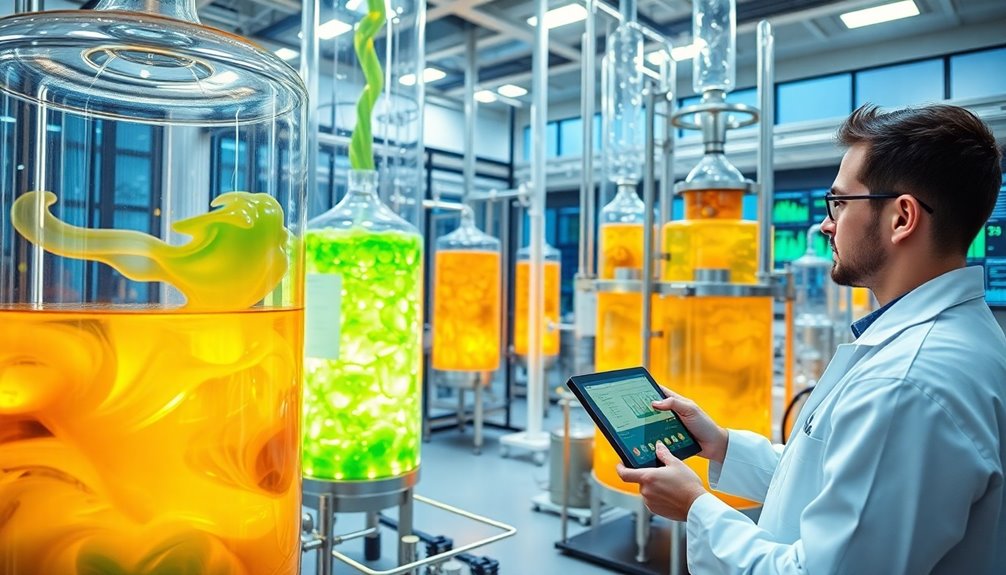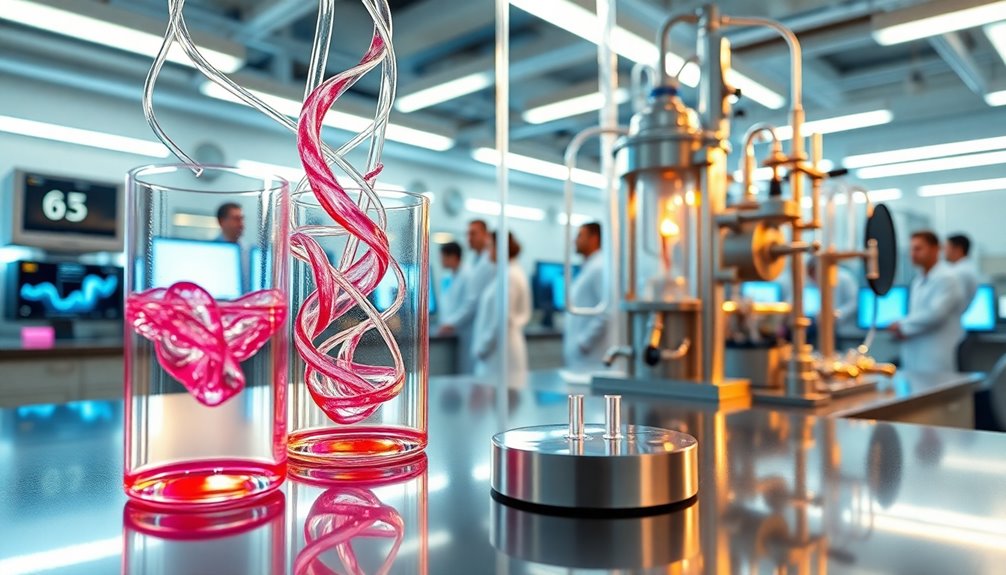Innovative online separation techniques are revolutionizing biobutanol production by enhancing efficiency and yield. These methods streamline recovery processes, cutting costs and reducing environmental impact. By optimizing fermentation conditions and utilizing advanced bioreactor systems, you can significantly improve product titer and overall output. The focus on integrating these techniques aligns with sustainability goals, offering a greener alternative to fossil fuels. Want to discover more about the advancements driving these improvements?
Key Takeaways
- Innovative online separation techniques enhance biobutanol recovery, reducing costs and improving overall yield during fermentation processes.
- Advanced methods like membrane filtration and adsorption can efficiently extract biobutanol directly from fermentation broths.
- Real-time monitoring and control of separation processes optimize fermentation conditions and improve product titers.
- Integrating online separation with bioreactors minimizes downtime and enhances the economic feasibility of biobutanol production.
- Continuous exploration of separation technologies contributes to sustainable energy solutions by increasing the competitiveness of biobutanol against fossil fuels.

As the world shifts towards sustainable energy solutions, improving biobutanol production becomes increasingly vital. One critical aspect of this improvement lies in the selection of feedstocks. You have a wide range of options, from agricultural waste and municipal waste to algae and lignocellulosic materials. By focusing on renewable and underutilized substrates, you enhance environmental sustainability and contribute to a greener economy.
Remember, raw material costs can account for over 70% of production expenses, making your choice of substrate essential for economic viability. Alternatives like sugarcane bagasse, algal biomass, and crude glycerol can be not only cost-effective but also sustainable.
Choosing the right substrate is crucial, as raw material costs can exceed 70% of production expenses.
An equally important factor is the fermentation process itself. Biobutanol production typically involves pathways like ABE and IBE fermentation. You'll find that specific microbial strains, particularly *Clostridium* species, excel at utilizing various substrates efficiently. Additionally, C. tyrobutyricum is recognized as a promising strain for biobutanol production due to its high butanol tolerance and simpler metabolic pathways.
By employing metabolic engineering techniques, you can enhance butanol tolerance and production rates, leading to better yields. Techniques like redox engineering in strains such as *C. tyrobutyricum* can significantly boost your biobutanol output. Utilizing advanced bioreactors with immobilized cells optimizes fermentation conditions, further increasing your product titers.
Innovative biotechnological advancements play a crucial role in enhancing biobutanol production as well. Genetic engineering can amplify specific genes in *Clostridium* strains, directly impacting production levels. Moreover, using engineered microbial consortia can improve overall yield while reducing carbon emissions.
Incorporating electrochemical methods can enhance carbon conversion efficiency, and developing novel recovery techniques is vital for making production cost-effective.
Ultimately, the goal is to increase yields, making biobutanol more competitive with fossil fuels. By continuously optimizing fermentation conditions and exploring various substrates, you can drive improvements in biobutanol production.
Working towards zero or negative CO2 emissions strengthens your commitment to environmental sustainability, ensuring that biobutanol remains a viable renewable energy source.
Frequently Asked Questions
What Are the Environmental Benefits of Biobutanol Over Traditional Fuels?
Biobutanol offers several environmental benefits over traditional fuels.
You'll notice it significantly reduces greenhouse gas emissions and utilizes organic waste, cutting landfill waste.
It's less corrosive and can be blended with gasoline at higher ratios, enhancing fuel diversity.
Its immiscibility in water minimizes pollution risks, and lower evaporation emissions help protect air quality.
How Does Biobutanol Compare to Ethanol in Terms of Energy Density?
When it comes to energy density, biobutanol's like a superhero compared to ethanol's sidekick!
You'll find biobutanol packs about 25% more energy, which means better mileage for your vehicle. While ethanol burns efficiently, its lower energy density can leave you stranded sooner.
Biobutanol's closer to gasoline, making it a fantastic blending option. So, if you're aiming for longer drives without frequent stops, biobutanol is definitely your go-to choice!
What Feedstocks Can Be Used for Biobutanol Production?
For biobutanol production, you can use various feedstocks like lignocellulosic biomass, agricultural residues, and waste streams.
Lignocellulosic biomass is abundant and cost-effective, while agricultural residues offer sustainability by repurposing waste.
Waste streams, like leftover beverages and cheese whey, help reduce pollution.
Each option has advantages, such as lower competition with food sources and environmental benefits.
Are There Any Health Risks Associated With Biobutanol Production?
Did you know that eye irritation from n-butanol can occur at concentrations as low as 15 ppm?
When it comes to biobutanol production, you face significant health risks. Exposure to irritants like butanol and acetone can lead to acute effects such as skin inflammation and eye irritation.
Long-term exposure raises concerns about central nervous system and reproductive health. It's crucial to implement safety measures to protect yourself and your coworkers in this industry.
What Are the Economic Implications of Large-Scale Biobutanol Production?
When you consider large-scale biobutanol production, you'll notice significant economic implications. It can lower production costs through economies of scale and improved efficiency.
However, you might face challenges in maintaining high yields and effective separation. By utilizing existing infrastructure and supportive government policies, you can reduce startup costs and stimulate local economies.
Ultimately, optimizing processes and enhancing supply chains can make biobutanol a more competitive and sustainable fuel option.
Conclusion
In conclusion, your journey toward enhanced biobutanol production showcases a significant stride in sustainable solutions. By embracing innovative online separation techniques, you're not just boosting biobutanol yields but also bridging the gap between science and sustainability. This remarkable refinement resonates with the relentless pursuit of renewable resources, paving the path for a prosperous, planet-friendly future. As you continue to explore these exciting advancements, remember that every effort counts in crafting a cleaner, greener world.









